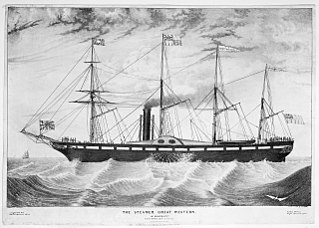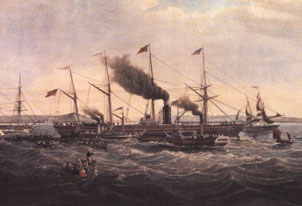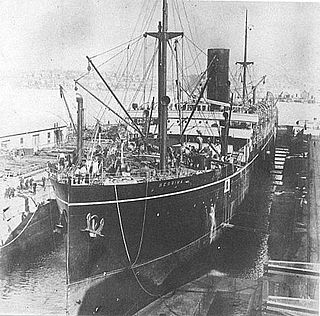Related Research Articles

A steamship, often referred to as a steamer, is a type of steam-powered vessel, typically ocean-faring and seaworthy, that is propelled by one or more steam engines that typically move (turn) propellers or paddlewheels. The first steamships came into practical usage during the early 1800s; however, there were exceptions that came before. Steamships usually use the prefix designations of "PS" for paddle steamer or "SS" for screw steamer. As paddle steamers became less common, "SS" is incorrectly assumed by many to stand for "steamship". Ships powered by internal combustion engines use a prefix such as "MV" for motor vessel, so it is not correct to use "SS" for most modern vessels.

A steamboat is a boat that is propelled primarily by steam power, typically driving propellers or paddlewheels. Steamboats sometimes use the prefix designation SS, S.S. or S/S or PS ; however, these designations are most often used for steamships.

SS Great Western was a wooden-hulled paddle-wheel steamship with four masts, the first steamship purpose-built for crossing the Atlantic, and the initial unit of the Great Western Steamship Company. Completed in 1838, she was the largest passenger ship in the world from 1837 to 1839, the year the SS British Queen went into service.

PS Waverley is the last seagoing passenger-carrying paddle steamer in the world. Built in 1946, she sailed from Craigendoran on the Firth of Clyde to Arrochar on Loch Long until 1973. Bought by the Paddle Steamer Preservation Society (PSPS), she has been restored to her 1947 appearance and now operates passenger excursions around the British coast.
The SS Cornubia was laid down in November 1856 and built in Hayle, Cornwall, by Harvey & Co. She was launched in February 1858 as a packet ship and ferry for the Hayle and Bristol Steam Packet Company. Sleek and painted white, with two funnels mounted close together amidships and with a high bridge over her paddle wheels, she plied the Hayle/St Ives to Bristol route in the days when the Great Western Railway had not penetrated as far as West Cornwall.

SS City of Glasgow of 1850 was a single-screw passenger steamship of the Inman Line, which disappeared en route from Liverpool to Philadelphia in March 1854 with 480 passengers and crew. Based on ideas pioneered by Isambard Kingdom Brunel's SS Great Britain of 1845, City of Glasgow established that Atlantic steamships could be operated profitably without government subsidy. After a refit in 1852, she was also the first Atlantic steamship to carry steerage passengers, representing a significant improvement in the conditions experienced by immigrants. In March 1854 City of Glasgow vanished at sea with no known survivors.
The shipping company is an outcome of the development of the steamship. In former days, when the packet ship was the mode of conveyance, combinations, such as the well-known Dramatic and Black Ball lines, existed but the ships which they ran were not necessarily owned by the organizers of the services. The advent of the steamship changed all that.
The West Cornwall Steam Ship Company was established in 1870 to operate ferry services between Penzance, Cornwall, and the Isles of Scilly. It became the West Cornwall Steamship Company in 1907 and was wound up in 1917.

John Harvey was a Cornishman whose career started as a blacksmith and engineer at Carnhell Green near Hayle, in west Cornwall. In 1779 he established a foundry and engineering works at Hayle called Harvey & Co. By 1800 the company employed more than 50 people and continued to grow as Harvey worked with many of the great Cornish engineers and entrepreneurs of the day. These included Richard Trevithick, William West, and, more importantly, Arthur Woolf. In 1797, Harvey's daughter, Jane, married Richard Trevithick.

The Great Western Steam Ship Company operated the first regular transatlantic steamer service from 1838 until 1846. Related to the Great Western Railway, it was expected to achieve the position that was ultimately secured by the Cunard Line. The firm's first ship, Great Western was capable of record Blue Riband crossings as late as 1843 and was the model for Cunard's Britannia and her three sisters. The company's second steamer, the Great Britain was an outstanding technical achievement of the age. The company collapsed because it failed to secure a mail contract and Great Britain appeared to be a total loss after running aground. The company might have had a more successful outcome had it built sister ships for Great Western instead of investing in the too advanced Great Britain.

The Great Western Railway's ships operated in connection with the company's trains to provide services to Ireland, the Channel Islands and France. Powers were granted by Act of Parliament for the Great Western Railway (GWR) to operate ships in 1871. The following year the company took over the ships operated by Ford and Jackson on the route between Wales and Ireland. Services were operated between Weymouth, the Channel Islands and France on the former Weymouth and Channel Islands Steam Packet Company routes. Smaller GWR vessels were also used as tenders at Plymouth and on ferry routes on the River Severn and River Dart. The railway also operated tugs and other craft at their docks in Wales and South West England.

Caird & Company was a Scottish shipbuilding and engineering firm based in Greenock. The company was established in 1828 by John Caird when he received an order to re-engine Clyde paddle-tugs.

The Scilly Isles Steam Navigation Company provided shipping services between Cornwall and the Isles of Scilly from 1858 to 1872.
The Bristol General Steam Navigation Company provided shipping services between Bristol and ports in southern Ireland, principally Cork from 1821 to 1980. There were also services to other destinations including ports in southern England, south Wales and France.
William Patterson Shipbuilders was a major shipbuilder in Bristol, England, during the 19th century and an innovator in ship construction, producing both the SS Great Western and SS Great Britain, fine lined yachts and a small number of warships.

The SS Nile was an iron-hulled cargo steamship. She is best remembered for her sinking in bad weather on 30 November 1854 with the loss of all hands, most likely after colliding with The Stones, a notoriously dangerous reef off Godrevy Head in Cornwall.
PS Queen of the Bay was a passenger vessel operated by the West Cornwall Steam Ship Company from 1873 to 1885
PS Guide was a passenger vessel built for the Dartmouth Steam Packet Company in 1869.
SS Lady of the Isles was a passenger vessel built by Harvey and Company, Hayle for the West Cornwall Steam Ship Company in 1875.
References
- ↑ Fenton, Roy (March 2009). "Cornish Steam Ships and Owners:the View from England" (PDF). Troze. The Online Journal of the National Maritime Museum, Cornwall. Falmouth: The National Maritime Museum Cornwall. Archived from the original (PDF) on 4 March 2016. Retrieved 7 October 2015.
- ↑ "Prospectus. Hayle and Bristol Steam Pcket Company (Limited)" . Royal Cornwall Gazette. Cornwall. 27 March 1857. Retrieved 8 October 2015– via British Newspaper Archive.
- 1 2 3 4 UK Retail Price Index inflation figures are based on data from Clark, Gregory (2017). "The Annual RPI and Average Earnings for Britain, 1209 to Present (New Series)". MeasuringWorth . Retrieved 7 May 2024.
- ↑ "No. 22565". The London Gazette . 15 November 1861. p. 4599.